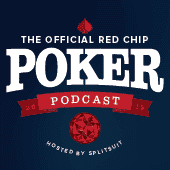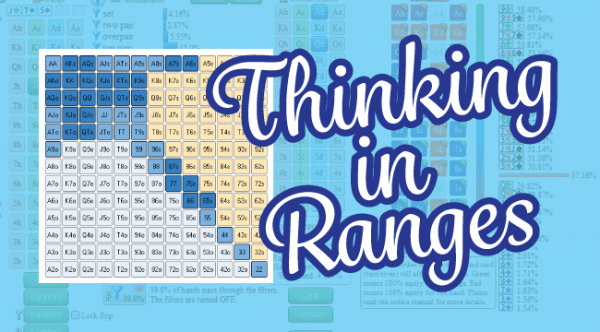Are you thinking in ranges?
Do you fear that you’re falling into a pattern of fit-or-fold when you don’t continuation bet on the flop?
Have you fallen into bluffing too much because it is the only way you can win the pot?
Are you bummed when you raise with aces and everyone folds?
All of these issues can be reframed into something much more productive when you really embrace your hand as just one part of your range that you happen to have this time.
So what does thinking in ranges entail?

Remember that your range is linear and logical. You should always be thinking about what hands you are representing to the table when you take certain actions. For example, if you raise a bunch of limpers, think about the hands others could put you on. Aces? Nines? Ace-king? It’s all there in their imaginations. Don’t make the mistake of focusing too much on the hand you actually have.
What does this do for your game?
BET SIZING & THINKING IN RANGES
One thing it will help with is that it will prevent you from giving off bet-sizing tells. For example, let’s say you raise preflop and get called, then see a flop of Q74 rainbow. Hull is making a slightly-over half-pot bet here with an enormous range of hands, from protection bets with 99, to value bets with a set of 7s, with top pair top kicker (AQ), or even two overs that didn’t connect (AK). He is making the same bet for all of these holdings, taking advantage of his opponents’ inelasticity in folding vs. calling or raising. He leaks no information, making it difficult for the opponent to play against him.
Hull will ask students what they’d do on a Q74 board with AQ vs. 88. Many say they’d bet almost full-pot with the top pair top kicker, but only about half-pot with eights to “see where they’re at”. This is a fatal mistake for any player paying attention to your bet sizing, because you are giving away the secret information and narrowing your range, making opponents’ decisions against you easier.
CONTINUATION BETTING WITH RANGES IN MIND
If you don’t find a continuation bet on this flop, you may feel like you’re becoming a fit-or-fold player. But if you’re thinking in ranges, you can see that there are actually many hands you could be c-betting with here, it’s just that you don’t happen to have one of them. That’s poker.
You should be letting the board dictate which hands you’re going to bluff with. Think about what other hands you could have in your range here. Don’t let your bluffing range get away from you. It’s easy to fall into the trap of, “The only way to win here is to bluff, so I’m going to fire a barrel or two.”
That is not sound strategic thinking. It’s easy to fall into the trap because sometimes these bluffs will work, giving you false positive feedback. Instead, you should think about the equity your hand has, but also, what kinds of cards could hit the turn and river that would allow you to bluff. If you see such a spot, and it makes sense given the range you’re representing with your actions, you have the green light to bluff. But bluffing for bluffing’s sake will be a leak that can cost you dearly.
Hull’s words of wisdom: “Whenever I pick bluffing hands, I like to pick hands that have outs to beat the most likely hands that will call me.”
“I SHOULD HAVE BET SMALLER TO GET ACTION”
Let’s say there are 4 limpers and you’re in the big blind. You raise with aces and everyone folds. You feel sad and think, “I should have bet smaller to get action.”
Maybe so, says Hull, but maybe not. Ask yourself if you would have bet the same with your bluffing hands. What other hands would you have made that squeeze with? 99? AK? A5s? How would you feel getting the pot uncontested with those hands? Pretty good, right?
If you’re thinking in ranges, you’re not going to sweat the table folding to the value-heavy part of your range. It means that they’re also going to fold to the weaker parts of your range, where you’ll be overjoyed to pick up the pot without any resistance.
PRODUCING MISTAKES IN OTHERS
One of the best side effects of thinking in ranges and balancing your range is that other players will have little information on which to base their actions. They will notice that you’re frequently winning without showing down your hand. And this will make them curious. As they become more suspicious, they’re liable to “look you up” with marginal hands, or make other mistakes that generate profit for you. They feel like they’re being taken advantage of, but they don’t know why or how. Give them every opportunity to make mistakes.
RESOURCES FOR DEVELOPING RANGE-THOUGHT
Hull recommends the book Applications in No Limit Hold’em by Matthew Janda as “one of your textbooks” if you were going to take a Ph.D in ‘pokerology’. It’s intimidating and a difficult read, but it’s well worth doing. But if you can digest its contents, you will have mastered thinking in ranges and have a huge leg up on the vast majority of players.
Poker’s 1% by Ed Miller is another great book to help you think in ranges, and is far more accessible to the average player. The basic thesis is that if you bet one street, you should usually bet the next. There should be a certain ratio of bluff-to-value that differs based on each street. On the flop, you should have 2 bluffs for every 1 value, on the turn 1:1, and on the river, 2 value for every bluff. There are, of course, a ton more details in the book.
But how do you actually do that?
One of the best resources available is Hull’s own Constructing Ranges series of PRO videos here on Red Chip Poker. Hull takes the Poker’s 1% rules (that were derived in some degree from Applications in No Limit Hold’Em), runs them through Flopzilla, and does the math of balancing ranges on given boards. You can start to get a sense of the bottom of your value betting range, and how many bluffs you should be including.
Another way to develop range-thought is to open up Flopzilla and put in your opening range for a given position. Let’s say there’s a limper and you raise on the button. You probably have a pretty good idea of what hands you would do that with. Put in the range and hit ‘random flop’, then decide which hands you would bet for value. You will find there’s a certain percentage. Now go in and add all your bluffs. Note the percentage. Then give yourself a random turn and repeat the process (limited to the range you started with). As you go to the river, you’ll get your tripe-barrel percentage as value and your triple-barrel percentage as bluffs.
Definitely check out James “SplitSuit” Sweeney’s Poker Workbook: Hand Reading for Live Players, where Sweeney has hand-picked flops, turns and rivers to test your ranging abilities against. You’ll be able to calculate your range and answer leading questions to learn specific lessons. (Don’t forget to go to the forums afterwards to post your results and get feedback.)
Finally, if you’re a PRO member, you can check out our Thinking in Ranges playlist which collects all the range-related PRO videos we have. After plowing through that playlist, your table won’t know what hit them!

